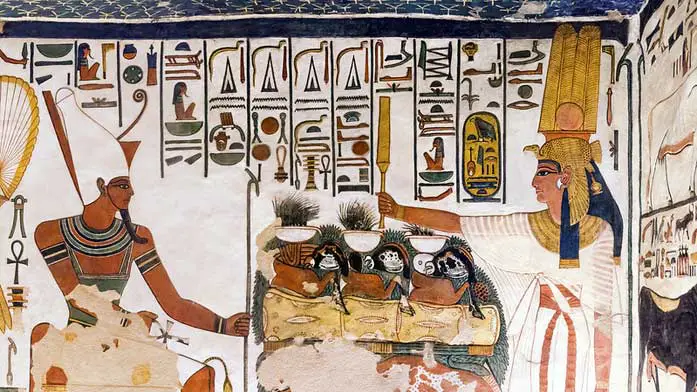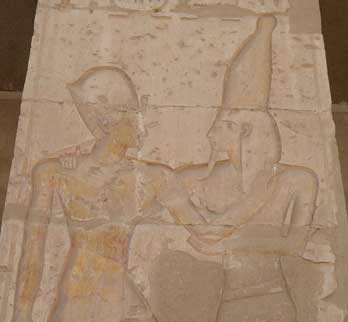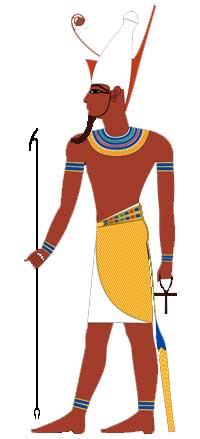Atum, the Creator of the World
Atum (also spelled Atem) was a primordial god to the ancient Egyptians and the ancestor of all other gods. He was often associated with the setting sun. He was also one of the oldest gods, since his origins date back to Pre-Dynastic times. He was eventually overshadowed by the sun god Ra in the New Kingdom period.
Name and Origins
The name Atum probably means "the all" or "the completed one." Two major myths about his origin exist. In one, Atum simply created himself. In the other, he was held inside an egg in the primordial waters before the creation of the world. In both myths, he went on to create Shu, the god of the air and Tefnut, the goddess of light. Shu and Tefnut created Geb, the god of the earth, and Nut, the goddess of the sky. This is why Atum was not simply considered the father of the gods; he was also the creator of the world.
Atum's real-world origins extend into the distant past of pre-Dynastic Egypt. As such, he may have predated the written word. Though he was one of several solar deities, he was the most prominent for roughly 2,000 years of Egypt's history, from before the First Dynasty to the early years of the New Kingdom.
Aspects - Prowness
Since he was most closely associated with the setting sun, Atum was also connected to the afterlife and the end of the world. In addition to his family, he was considered the father of the living pharaoh.
He was the god of both the beginning of all things and the end of all things. Ancient Egyptian myth tells the story of an Atum that will end the world, returning it to the endless primordial waters that existed before the world began.

© kairoinfo4u - Atum & Nefertari
in the tomb of Nefertari
Associations - Family
Atum was part of the Great Ennead, a group of nine deities worshipped at Heliopolis. The others were his children, the god Shu and the goddess Tefnut, his grandchildren Geb and Nut, and his great grandchildren Osiris, Isis, Set, and Nephthys.
Atum was also partnered with the other solar deities like Ra and Khepri. As a trio, they governed over the rising, noon-day, and setting sun as it traversed the daytime sky. The merging of Atum's qualities with Ra during the Amarna period is testament to how closely associated these gods were.
Atum had three consorts, each from differing myths that originated in different cities or regions. One was Iusaaset, Atum's female counterpart. In one creation myth, Atum created the first deities with his hand. Accordingly, Iusaaset was often called the "hand of Atum." Another consort was Nebet-hetepet, who fulfilled a role very similar to Iusaaset's.

Aidan McRae - Thomson & Atum
In some myths, Atum's consort was Mut, a primordial goddess also said to have created the world. Mut's name means "mother." In these myths, Atum and Mut were the patron deities of the city of Thebes. Along with Heliopolis, Thebes was one of the major religious cities that had a priesthood dedicated to Atum.
Depictions
Atum was most often depicted as a human king seated on a throne while wearing the double crown of Upper and Lower Egypt. On his chin was a false beard that the pharaohs wore to denote their divinity. When standing, he was often depicted with a shepherd's staff. When representing the setting sun, he was shown in much the same way, but as an old man. At times, he was depicted in the same way but with a ram's head.
He was also represented by a large snake, serpent, or eel. This was his primordial form, since the serpent is considered an animal capable of swimming in the primordial waters before and after time. More rarely, Atum was depicted as a mongoose, a creature capable of killing the snake. This is connected to the god's role at the end of time and his ability to destroy as well as create.
In some very rare images, Atum was represented by a cat or scarab beetle. The cat was considered a creature with a domain in both the living and unliving realms, while the scarab is associated with self-healing, self-creation, and regeneration. Finally, he was sometimes depicted as either a lizard or a baboon wielding a bow and arrow.
Important Myths
Atum was not merely the father and mother of the world. He was also its ruler. This "right to rule" was passed down from Atum directly to the pharaohs. Hence, the mythology of Atum as ruler was used to legitimize the rule of the current king. This legitimizing would happen with each successive pharaoh through coronation rituals centered around Atum.
Before the creation of the world, Atum took into himself a mind, a heartbeat, and the breath of life. In so doing, he became matter separate from the primordial waters, transforming into the mound of land in the waters that represented the created earth.
Yet this was not the only act of creation by Atum. When Shu and Tefnut left him to explore the primordial waters, he became dejected and frantic. He sent the Eye of Ra (his noon-day counterpart) in search of them. When they were found and returned, Atum wept tears of joy. Those tears became the first human beings. This made humans distinct from the gods, who, according to the Heliopolitan and Memphite theologies, came either from Atum's his saliva.
A variation of the creation myth involves Atum's disapproval of Geb and Nut. In this version, Nut and Geb, who were siblings, fell in love. To keep them separate, Atum pushed Nut into the sky. This act cleared room for the earth to be inhabited by humans.
His female counterparts and consorts were each referred to as the "Hand of Atum," much in the same way that Ra's consorts were called the "Eye of Ra." However, his close association with the royalty of Egypt was the longest lasting myth about him. In the Pyramid Texts, Coffin Texts, and the Book of the Dead, there are mentions of the pharaoh becoming Atum in death.
He was purported to be one of two gods who would survive the end of the world. He and Osiris would transform into snakes as the earth disappeared. They would then swim in the primordial waters until a new world was created.
Evolution
As early as the Pyramid Texts (composed around 2400 BC), Atum was one of the principle gods, overseeing both the birth and death of the world, as well as the birth and death of the day and those of individual humans. He was mentioned more than any other god in the Texts. In some lower Kingdom depictions from the time of Ramses II, Atum was shown crowning each new pharaoh. This points to Atum's possible origin as a god worshipped primarily in the Lower Kingdom beside an Upper Kingdom counterpart whose identity is now lost to history.
During the Amarna Period
The Amarna Period (in the middle of the 14th century BC) was a time of religious and social upheaval. The pharaoh Akhenaten declared that only one god could be formally worshipped and revered. He elevated a lesser-known sun god named Aten to this position.
Aten absorbed qualities of both Ra and Atum. Like Atum, he was said to have created the world. He also became responsible for the crowning, rule, and health of the pharaoh. He was the ruler associated with the sun throughout its course in the sky (unlike the trio of Khepri, Ra, and Atum, who ruled over the sun at different times of the day).
In Later Times
By the middle of the New Kingdom, Atum had been declining in importance for nearly a millennium. He was supplanted primarily by Ra. However, Atum was still worshipped by small cults and by an order of priestesses called the Divine Adoratrices of Amun. Even as Ra became the chief sun god, Atum was worshipped due to his closeness to the pharaoh and his station as creator and ender of the universe.
Rituals and Prayers
Atum figured into rituals surrounding the pharaoh's coronation and those performed by the dead pharaoh as he crossed into the afterlife. The Pyramid Texts were the primary source for these rituals, and Atum's name appeared in them more than any other god.
The Egyptian Book of the Dead provided instructions to the pharaoh as he moved into his next stage of existence. In this text, Atum was mentioned nearly as much as Osiris, the god of death.
Biblography
- The Egyptian Myths. London: Thames and Hudson, 2014.
- Egyptian Gods. New York: Independently Published, 2020.
- The Complete Gods and Goddesses of Ancient Egypt. New York: Thames &Hudson, 2003.
- The Gods of the Egyptians or Studies in Egyptian Mythology. London: Methuen and Company, 1904.

